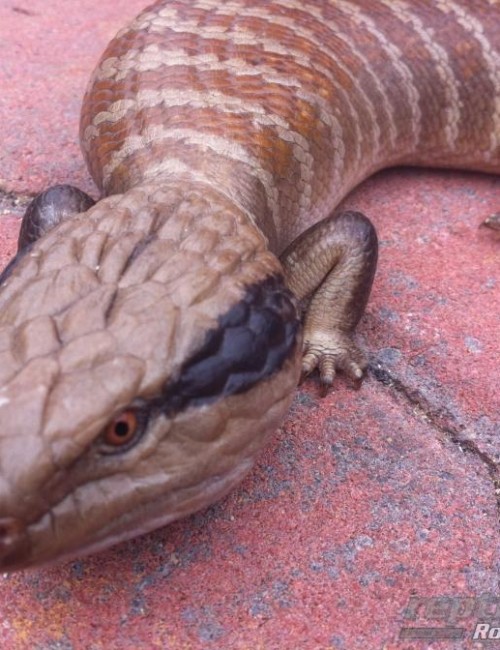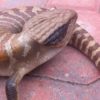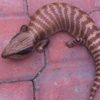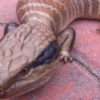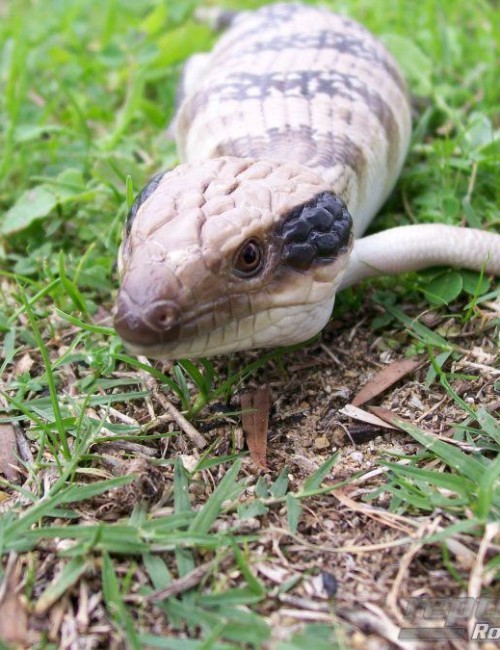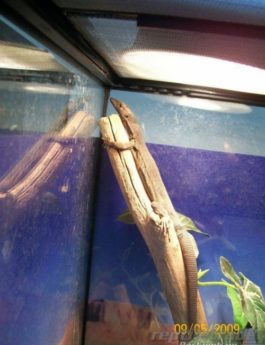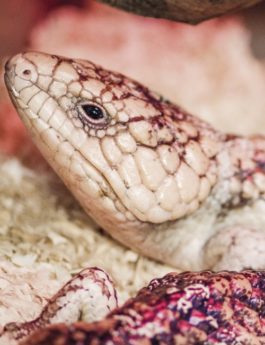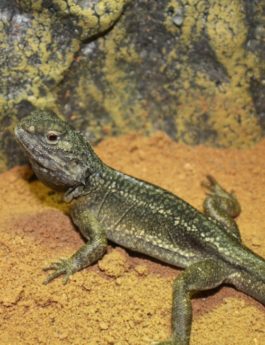Robust Tiliqua with short slightly depressed angular head, very short body, short slender tail and smooth scales. Ground colour pale grey to greyish-brown, bearing approximately 9-12 orange to yellowish-brown bands (broader than pale interspaces) between nape and hips, and 8-10 on tail. Prominent broad black stripe extends from eye to above ear. Ventral surfaces white to cream, often bearing dark variegations on throat. SVL 250mm.
Usually shelters in shallow burrows beneath dead vegetation and surface debris. Otherwise as for genus. Semi-arid to arid red sand plains, dunes or stony hills vegetated with hummock grass associations. Extends from north-western WA, through central Australia to interior of Qld and far north-western NSW.
Terrarium: Centralian Bluetongue’s are a ground dwelling lizard, it is not essential to provide an enclosure with much height, however it is important to have plenty of ground space for them to comfortably move around their enclosure. A terrarium size of 90x45x45 (WxDxH) would be suitable to house 1 large adult, if you wish to house 2 or 3 bluetongues 120x60x60 would be better suited. In the warmer months Bluetongues could be housed in an escape proof outdoor enclosure that receives at least 8 hours of natural sunlight a day, has plenty of shade and a permanent dry area.
Lighting & Heating: Centralian Bluetongues are primarily diurnal, therefore require high spectrum UVB lighting as well as an intense basking heat source when housed indoors. There are a number of ways to provide UVB, fluorescent 10.0 spectrum tubes or bulbs will provide UVB, a daylight basking heat globe will have to be used in conjunction. A mercury vapour globe will provide intense UVA & UVB light, mercury vapour globes are in our opinion superior to fluorescents as it is a longer lasting globe with more intense UVB output, however they cannot be used with a thermostat so work better with a larger enclosure that will easier maintain a thermal gradient. During the day, you want to achieve a basking ‘Hot Spot’ of 35°C and an air temperature ranging from 35°C in the hot end, and down to 20-25°C in the cool end. A heat rock or heat tile should be provided as tummy heat to help with digestion, this can also be used as a night time heat source. To monitor the temperatures inside the enclosure a thermometer should always be used.
Furnishings: A Bluetongue’s enclosure is fairly basic as far as furnishings, they don’t require logs and vines for climbing, however a large log on the ground provides a natural hiding spot. Two large, low hide rocks should be provided, one in the hot end and one in the cool end with the water bowl. Artificial foliage throughout the enclosure will allow the Bluetongue plenty of hiding spots and coverage. A pet bedding wood chips such as Chipsi or Critter Crumble can be used as a substrate.
Food in captivity: Centralian Bluetongues will eat just about anything offered to them, they should be fed 2-3 times a week, varying their food will ensure a balanced diet. Their diet should include a variety of fruits and vegetables. Small mice, raw meat and canned pet food should be given in moderation, calcium and vitamin supplements should occasionally be added to their food.
The essentials:
- Terrarium of appropriate size
- High spectrum UVB lighting
- Daytime Basking globe
- Thermometer
- Ground heat
- Water bowl & Food bowl
- Substrate
- Large hide rocks
- Foliage for shelter
- Calcium and vitamin supplements

